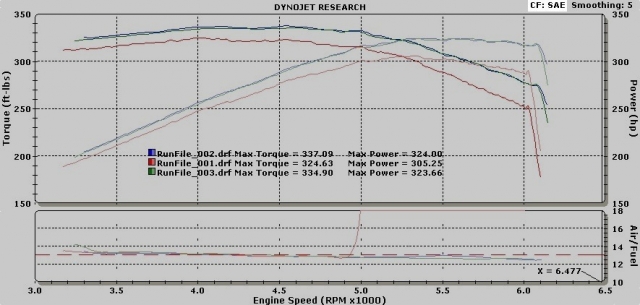The automotive dynamometer has one main task – to measure automotive horsepower and torque in a controlled environment. There’s much more to it than just that, however, and after you’re done reading this article, hopefully you’ll have a better idea of what’s involved in using one to determine just how much power you’re putting down on the road (or track).
A number of different styles of dynamometer have been invented over the years, and for the purposes of this article we’re going to focus on one in particular – the Dynojet 224xLC, which is currently installed in the Power Automedia shop. That’s right; we use one of these regularly to test out all of the modifications we make for the many different internet magazine titles under our roof.

Time to mark out the space where our dyno was to be installed. Disregard the high-quality artwork, it’s merely a placeholder.
Horsepower to the Wheels
Before we get ahead of ourselves, let’s talk a little bit about how a dyno operates. In this case, we’re talking about a “chassis dyno” that measures horsepower at the wheels, as opposed to an “engine dyno” that would be used to measure power and torque of an engine separate from the car itself. The chassis dyno houses a high-inertia steel drum that is turned by the vehicle’s tires while in gear, offering the operator the chance to do safe, reliable road testing without ever leaving the shop’s premises.
It’s useful not only for performance shops, but also general repair facilities, especially those performing diagnostic work, as it can assist the operator in diagnosing electrical glitches, fuel, clutch, or torque converter problems in order to give you the safest and most reliable vehicle possible.
The 224xLC is a “hybrid style” dynamometer that uses an Eddy Current Load Absorption cell (electric brake) in combination with the inertia roller (drum) to provide resistance, and the load absorber’s magnetic field’s strength can be varied to control the amount of braking, or load, applied to the dyno’s roller. According to Dynojet’s Will Fong, “When performing non-load tests, you accelerate the inertia roller in a roll-on test (one-to-one gear, usually 4th) to measure the power of the vehicle. The inertia method is super-consistent, reliable and repeatable because the load (of the roller inertia) is fixed.”
Adding the eddy current brake increases the versatility of an inertia dyno by allowing the dyno operator to increase the amount of resistance applied, like adding more weight to a Nautilus machine. The electromagnet’s power is computer-controlled, helping to match the power output being applied to the dyno. This helps to load down the engine and provide it with something to “push” against, resulting in a simulation of the forces that would be applied to a car on the road – the vehicle’s weight, wind resistance, rolling resistance, and so on. This variable resistance, and the ability to “hold” the engine at a particular speed and throttle position, allows all sorts of different tests to be performed (more on that in a bit…)
Cutting out the hole - who doesn't love demolition work? This was best left to the professionals. While we're capable of lots of things, pouring concrete isn't one of them, and the dyno needs a super-strong foundation.
Getting Started
For a vehicle owner that’s never had a car strapped down to a dynamometer before, there are bound to be some questions like “What do I need to know?” “How do I interpret my results?” and “What questions should I ask the guy who’s about to abuse my new car?” So let’s dive right into those questions, and explain a bit about what you can expect when you make an appointment with your local dyno shop.
First off, if you are scheduling a dyno appointment to have your car tuned, then you’ll need to make sure that the car is in good working order. That means the spark plugs are fresh, preferably fresh oil, and no other mechanical issues with the car that you know about.
Of course, if you’re making an appointment to have an issue diagnosed, it is very helpful to let the dyno operator know about these things right up front; that way he or she can plan to spend extra time on your car figuring out what is wrong with it, rather than having you schedule an appointment and then surprise them with “oh, but it doesn’t run smooth above 3500 RPM” – remember, the dyno operator is your friend.
Rigging up the dyno itself, and preparing for installation. As you can see from the use of the forklift, this isn't something you can just pick up and drop into place. Measure, and then measure again - it needs to be square within the foundation for proper operation. Dynojet provides complete pit construction blueprints with every dyno they sell.
Fong also clued us in on a couple of questions that you should ask your dyno operator. “Does the dyno have the analog module for reading boost pressure? We sell an option called the Analog Module that allows input of up to four, 0-5v analog inputs, for reading things like boost pressure, temp, etc. This is mainly used for getting boost pressure. We sell pressure sensors or the dyno owner can supply their own,” he said.
Dynojet dynamometers also typically feature wideband oxygen sensor monitoring, which allows the operator to see exactly what is happening with the engine – whether it’s rich or lean and how the engine’s tuneup is performing under real-world conditions. This takes the guesswork out of the tuning operations for the operator and can be printed on your dyno graph at the end of your session as well.
Fong points out there are a couple ways to connect the air/fuel ratio module. “We offer this as an option that allows for either threading the dyno AFR oxygen sensor into an O2 bung or a compressed air pump system for putting a probe into the rear exhaust for readings,” he explained.
Prior Planning Prevents Poor Performance
There are a few specific steps involved in a successful dyno session, according to Fong. “You need to have a baseline run performed. This will take less than an hour and consists of a handful of runs after the vehicle is up to operating temperature in order to get a consistent baseline. The baseline lets you evaluate the performance and operating condition of your car and helps you to determine what modifications, tuning adjustments, etc. you may want or need. This is usually a flat fee for a set number of dyno runs. If you scheduled a specific time for the dyno runs, it is a good idea to get to the shop early enough for a cool down, especially with a forced induction application. A heat soaked supercharged motor as a good example. It’s better to get the car warmed up on the dyno and make your hits just as it comes up to temp,” said Fong.
Fresh oil, fuel and spark plugs are a must when you head to the dyno. Dyno time is affordable, but it does cost money, and there's no sense wasting it with fluids and spark that may not be up to par.
One of the great things about Dynojet is that no matter where you have your car tested, the results are directly comparable to any other Dynojet. Fong continued, “You should already have a baseline done, preferably from the same shop so they can view the dyno run data for comparison. You’ll at least want the previous baseline to have been from another Dynojet and also bring the dyno run(s) in digital format on a USB drive or CDROM. The dyno operator can load the dyno runs on his PC to compare. If the shop isn’t going to supply parts and if you have upgrade parts, bring them with you (bigger throttle body, intake/inlet, injectors, boost a pump, etc.). Tuning costs will vary depending on the level of tuning, software/hardware included, the geographical area, etc.”
There’s nothing worse than getting on the dyno to start tuning and realizing you can’t continue because you forgot to bring parts with you! – Will Fong, Dynojet
There’s No Way to Cheat
One thing to keep in mind is that a Dynojet dyno operator cannot manipulate the results that the dynamometer displays; it is what it is – the results are rooted in physics. Whatever power is applied to the drum will be measured and displayed. Where the confusion sometimes comes in lies in the fact that the operator can choose to display those results in either corrected or uncorrected form. Since the 224xLC dyno, and all of Dynojet’s other products come standard with a weather station that measures atmospheric variables like atmospheric absolute pressure (not barometric pressure), temperature, and humidity – all things that play a large part in ultimate power production – the results can be analyzed as “corrected” values.
This allows an apples to apples comparison; for example, if you’re spinning the roller on two consecutive days with a 20-degree temperature change, or a humidity bump, between them. The same car with zero changes between days will definitely make less power on the 80 degree day compared to the 60 degree day, but by applying the SAE correction factor between the two runs in the Dynojet software, you will get an accurate picture of what’s happening. Make sure your dyno operator is using the SAE correction, not the STD correction factor, as that is an older standard that will skew the numbers upward.
Hooking up the control stack - this includes the wideband oxygen sensor monitor and other options particular to the dyno installation.
Beyond Just Measuring Horsepower
One of the terms that you may hear the dyno operator say is “load control”. One of the main things that a Dynojet 224xLC dynamometer is capable of is placing a load on the vehicle in order to help it exhibit the same types of characteristics that it might rolling down an actual road – this is called load control, thus the “LC” in the model designation. Load control is extremely helpful in diagnosing running issues – if you’ve got an automatic transmission that’s shifting late, or spark breakup at higher RPM, the dyno will show those things, and show them quickly.

Our old building had an above-ground dyno installation. It works the same way as our new in-ground 224xLC, but the in-ground installation frees up a lot more space in the shop for other work.
If that happens when you’re at the dyno, don’t assume the dyno operator has done something wrong, because it’s very possible that the vehicle may have had the same issues before you rolled in the door and just didn’t know it. The spark monitoring system will show issues like that immediately, and the dyno even has the ability to help the operator diagnose intermittent issues as long as they crop up while the car is on the rollers.
The dyno will store each run in the computer, giving you the ability to overlay one run against another and see exactly what difference particular changes have made throughout the entire RPM range. In addition, the testing equipment will measure atmospheric absolute pressure and ambient air temperature along with humidity measurements, so that you can see exactly how each of these factors can affect one run versus another.
How To Read A Dyno Graph
The Dynojet WinPEP software allows your dyno run to be displayed as a graph with vertical and horizontal axis. It can also be displayed in a chart format that can be viewed and/or exported as a text or delimited file for use in a spreadsheet or exported as an image file. WinPEP is available on Dynojet’s website for free download so you can view your runs. WinPEP allows you to create a split graph, sectioned into one, two or three sections for easier viewing.
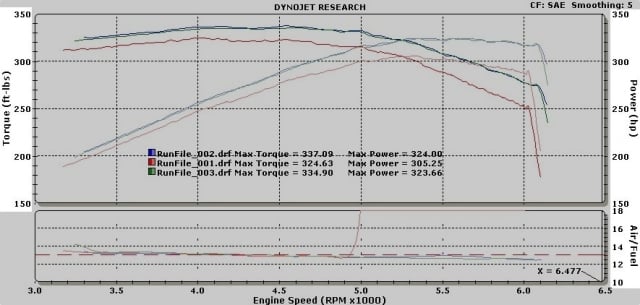
The left and right vertical axis selections – this will be horsepower, torque and any other data sampled such as air/fuel ratio, analog inputs such as boost pressure, etc.
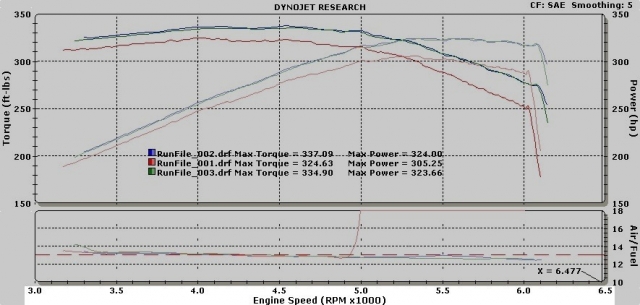
The bottom horizontal axis – this will be engine RPM, speed, or time. Horsepower is usually displayed on the left axis, engine RPM or speed at the bottom, and torque on the right.
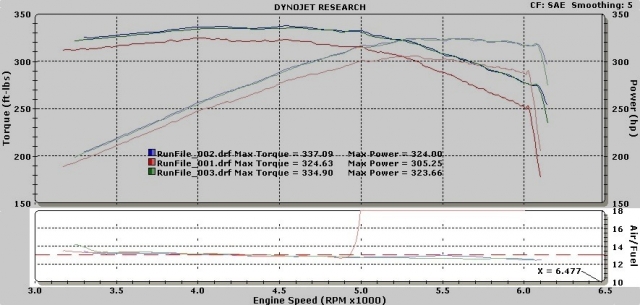
Using the split graph feature, usually air/fuel ratio or an analog input such as boost is displayed.
Testing to the Limit
The 224xLC that’s installed at the PAM World Headquarters is capable of measuring up to 2,000 horsepower, and 200 MPH, meaning that just about any vehicle you can think of can be tossed on the roller to see how it stacks up. But measuring horsepower is just the beginning of the 224xLC’s capabilities – it can do so much more than just post a big number on a computer screen. It’s capable of performing load tests including step, sweep, and loaded roll-on testing, and the operator can also load test in closed-loop operation and target engine RPM, speed, or a percentage of load.
Fong discussed the advantages of step testing with us. “Step allows you to define a specific step-test profile, usually chosen based on engine RPM (2,000-2,250-2,500, etc.) with the hold time for each step in seconds. The operator controls the acceleration via gas pedal and the WinPEP software holds the car under load at each step point for the specified time period. Steady-state and step are generally used during ECU/PCM calibration or drivability testing. “Sweep” allows the operator to add an additional amount of load using the eddy-current for increased loading while performing a roll-on full throttle test. This test is used when additional load (such as in certain turbo applications) is needed or a longer sample time is desired,” he said.
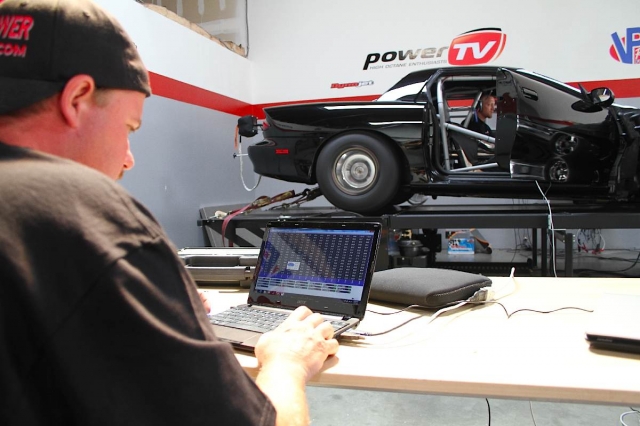
World-renowned tuners like Horsepower Connection’s Brian Macy have relied on Dynojet dynamometers for years. Here Brian is tuning on our BlownZ project car at the old shop. You can see the cramped quarters – each car had to be backed onto the dyno. With the in-ground installation at our new digs, we don’t have that issue any more.
The Dyno Remembers All…
Dynojet’s WinPEP7 software allows the dyno operator to store many thousands of runs in their shop’s computer – every car that’s ever spun the roller in that particular facility will be cataloged by make, model, and customer name. Not only is this helpful in case you need a copy of your dyno printout later, it’s also helpful to the operator, as he’s able to compare runs from other vehicles he’s worked on that might be similarly modified in the case of a diagnostic issue.
As you can see, the Dynojet dynamometer is a tool like any other; although it won’t add a single pony to your car by itself, it has an irreplaceable value in the diagnostic world to get the most out of everything you’ve had done to your engine, along with the ability to display that huge four-digit horsepower number you were after when you laid waste to your bank account.

















